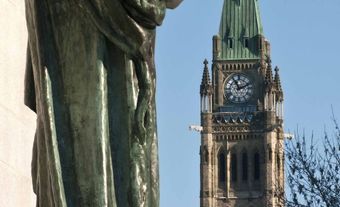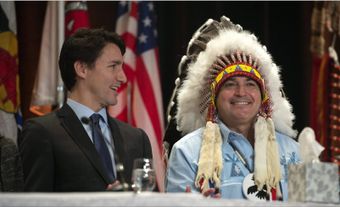Public Ownership
Public ownership refers to government provision of goods and services; the commercial or business activities of the STATE. Although the boundaries between the public and private sectors have been blurred by governments' expanding role in the economy, public ownership generally refers to enterprises, wholly or partially government owned, which sell goods and services at a price according to use. According to this definition, government-owned railways, airlines, and utilities are examples of public ownership, but hospitals, highways and public schools are not. In Canada the latter are provided by the state but are financed primarily by general government revenues, not by fees paid by individuals in relation to the quantities of goods or services produced. Such a definition, though not absolute, does distinguish public ownership from private ownership and other sorts of state activity.
Although many Canadians probably believe private enterprise dominates their economy, public ownership is important at all 3 levels of Canadian government. For example, in 1987 the federal government owned AIR CANADA, Canada's largest airline; CANADIAN NATIONAL RAILWAYS; the CANADIAN BROADCASTING CORPORATION and PETRO-CANADA; as well as coal and uranium mines and financial institutions. Provincial public ownership is very diverse. Not only are most provinces involved in the generation and transmission of electricity (see UTILITIES), the retail sale of liquor and the provision of financial services to farmers and small businesses; but telephone service in the Prairie provinces, railways in BC, Alberta and Ontario, steel mills in Québec and Nova Scotia, automobile insurance in several provinces, and energy companies in most provinces are also publicly owned. Public ownership is also important in Canadian municipalities where it may include the provision of urban transportation, water, electricity and, in a few cases, notably Edmonton, telephone service.
Although the election of NEW DEMOCRATIC PARTY provincial governments has led to greater public ownership, Canadian governments do not resort to it out of political ideology. Public ownership, which generally supplements private enterprise and the market, is used to promote economic growth through the provision of economic infrastructure, to achieve federal and provincial control over certain firms and industries, to maintain employment and to promote national security. Private enterprise has not always been willing or able to provide important goods and services in such a large, sparsely populated country. The threatening presence of the US, the need to extend important services over vast distances, and regional and cultural forces have played a large role in determining the use of public ownership.
However, public ownership has not been uncontroversial in Canada. Public ownership of hydro in several provinces, the nationalization of automobile insurance in BC and Manitoba, and the creation and growth of Petro-Canada are a few of the government actions that evoked conflict about government's role in the economy. The effectiveness of Canada's burgeoning public-enterprise sector has been seriously questioned. Some interests now argue that public ownership has been too widely extended in Canada, a common prescription being the "privatization" (return to private ownership) of a number of publicly owned firms.
Since 1984, the federal Progressive Conservative government of Brian Mulroney has pursued an active privatization program. Several crown firms, including Canadair and de Havilland, have been sold to private investors, the latter to Boeing Aircraft of Seattle in a controversial sale. Petro-Canada, Air Canada and the CNR have also been named as possible candidates for sale to private interests. Privatization also proceeds apace in the provinces. In late 1987, the Social Credit government of BC provoked an intense debate when it released a blueprint for the privatization of many government firms and services. Public ownership also has many supporters and defenders. It remains an important policy instrument for Canadian governments of diverse persuasions.
Public ownership in Canada has been achieved in several ways. Occasionally governments have created new firms, or less frequently they have acquired or nationalized private ones. The NATIONALIZATION of industries such as potash in Saskatchewan, asbestos in Québec and hydroelectric power in Ontario has been very controversial. However, the owners of firms that have been nationalized normally received financial compensation.
Public ownership is generally administered through a CROWN CORPORATION, but a publicly owned industry need not be in corporate form. Government departments may also administer state-owned businesses. Recently, governments have employed "mixed" corporations that involve, in varying degrees, public and private ownership within a single firm.
The ALBERTA ENERGY COMPANY, a firm owned jointly by the Alberta government and many individual Canadian investors, is a good example of a mixed enterprise. But the political and economic effectiveness of such enterprises remains undetermined. But concern is often expressed about whether such firms can reconcile in their decision making the sometimes conflicting imperatives of public-policy goals and the pursuit of profit.

 Share on Facebook
Share on Facebook Share on X
Share on X Share by Email
Share by Email Share on Google Classroom
Share on Google Classroom


